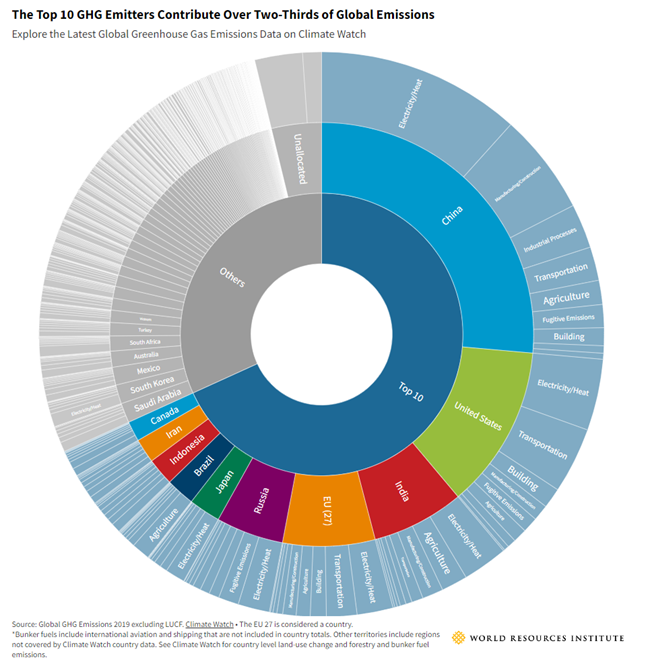Appendix 2 - Climate Science and Goals
Overwhelming evidence has led to the scientific consensus that climate change is the greatest environmental challenge of the 21st century. Climate change is the result of global warming, which is the long-term hearting of Earth’s surface due to human activities, primarily fossil fuel burning, which increases heat-trapping gases in Earth’s atmosphere.

Although the natural greenhouse effect is needed to keep the earth warm, human activities like the burning of fossil fuels have increased the accumulation of GHGs in the atmosphere to levels that are unhealthy for humans. Unprecedented concentrations of these gases in the atmosphere has led to too much heat and radiation being trapped on Earth.
What are Greenhouse Gas emissions? Carbon dioxide (CO2) is the most common greenhouse gas. But there are numerous other greenhouse gases, including methane (CH4), nitrous oxide (N2O), and fluorinated gases. Each of these greenhouse gases has a different “global warming potential (GWP),” or amount that a certain gas warms Earth compared to CO2 over the same period of time. For example, Methane (CH4) is estimated to have a GWP of 27-30 over 100 years, while CO2 has a GWP of 1. A “carbon dioxide equivalent” or CO2e, is a measure that allows us to calculate and compare GHG emissions in a standardized way.
Current status of climate change Carbon emissions from human activities have soared in recent decades and are currently at the highest rates in human history. According to the Institute for European Environmental Policy (IEEP), about half of all carbon dioxide emitted between 1751 was emitted in the last 30 years.

Figure 7 Tons of GHGs emitted between 1850 and 2022 (Source: World Resources Institute)
Data from the World Resources Institute (WRI) shows that 10 countries contribute over two-thirds of global emissions, with the United States being the second-largest emitter behind China. The United States is the single largest emitter of GHGs per-capita.

Figure 8 Top GHG emitters by country and sector. Source: World Resources Institute
Global Climate Goals To avoid the worst impacts of Earth’s warming, the United Nations’ Intergovernmental Panel on Climate Change (IPCC) established a goal to limit the global average temperature increase to +1.5°C from pre-industrial levels. For reference, pre-industrial temperatures were approximately 13.5°C (56.3°F).The global temperature on Earth has already increased by at least 1.1°C since 1880, according to ongoing temperature analysis led by scientists at NASA’s Goddard Institute for Space Studies (GISS). Recent research indicates that the +1.5°C limit will be difficult to achieve.
National Climate Goals The +1.5°C goal, which came out of the 2015 Paris Agreement, also came with commitments from 196 “Parties,” to reduce their GHG emissions. 195 Countries and the European Union signed the Paris Agreement, which is a legally binding international treaty. The Obama and Biden administrations signed the Paris Agreement, pledging to achieve a 50-52% reduction from 2005 levels in economy-wide net greenhouse gas pollution by 2030. Biden also included goals for a carbon pollution-free power sector by 2035 and a net zero emissions economy by no later than 2050. The Trump Administration has pulled the United States’ out of this agreement. Regardless, atmospheric concentrations of dangerous gases continue to accumulate, and the impacts of wildfires, air pollution, floods, storms, urban heat and uncertain energy availability continue to ravage our region and strain our County’s and region’s capacity to respond. Washoe County remains committed to working together regionally to provide and sustain a safe, secure, and healthy community. Pursuing our goal of Net Zero greenhouse gas emissions by 2050 offers the best pathway forward to reduce pollution; improve our region’s access to clean, reliable and affordable energy; and strengthen the capacity and resilience of our community to respond to natural and man-made disasters.
Nevada Climate Goals In 2019, the State of Nevada Legislature passed Senate Bill 254, establishing the following GHG reduction targets:
- 28 percent by 2025
- 45 percent by 2030
- Net-Zero by 2050
Washoe County is contributing to the State’s emissions reduction goals by committing to Net-Zero by 2050. Washoe County’s “baseline year,” against which reductions will be measured, is 2021.
